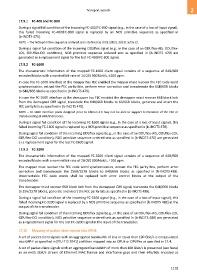Page 1189 - 5G Basics - Core Network Aspects
P. 1189
Transport aspects 2
17.9.1 FC-400 and FC-800
During a signal fail condition of the incoming FC-400/FC-800 signal (e.g., in the case of a loss of input signal),
this failed incoming FC-400/FC-800 signal is replaced by an NOS primitive sequence as specified in
[b-INCITS 470].
NOTE – The NOS primitive sequence ordered set is defined as /K28.5/D21.2/D31.5/D5.2/.
During a signal fail condition of the incoming ODUflex signal (e.g., in the case of an ODUflex-AIS, ODUflex-
LCK, ODUflex-OCI condition), NOS primitive sequence ordered sets as specified in [b-INCITS 470] are
generated as a replacement signal for the lost FC-400/FC-800 signal.
17.9.2 FC-1600
The characteristic information of the mapped FC-1600 client signal consists of a sequence of 64B/66B
encoded blocks with a nominal bit-rate of 14 025 000 kbit/s, 100 ppm.
In case the FC-1600 interface at the mapper has FEC enabled the mapper must recover the FEC code word
synchronization, extract the FEC parity bits, perform error correction and transdecode the 64B/65B blocks
to 64B/66B blocks as specified in [b-INCITS 470].
In case the FC-1600 interface at the demapper has FEC enabled the demapper must recover 66B block lock
from the demapped CBR signal, transcode the 64B/66B blocks to 64/65B blocks, generate and insert the
FEC parity bits as specified in [b-INCITS 470].
NOTE − FC-1600 interface ports designed prior to Edition 4.6 may not be able to support termination of the FEC or
transdecoding of 64B/65B blocks.
During a signal fail condition of the incoming FC-1600 signal (e.g., in the case of a loss of input signal), this
failed incoming FC-1600 signal is replaced by a NOS primitive sequence as specified in [b-INCITS 470].
During signal fail condition of the incoming ODUflex signal (e.g., in the case of an ODUflex-AIS, ODUflex-LCK,
ODUflex-OCI condition), NOS primitive sequence ordered sets as specified in [b-INCITS 470] are generated
as a replacement signal for the lost FC-1600 signal.
17.9.3 FC-3200
The characteristic information of the mapped FC-3200 client signal consists of a sequence of 64B/66B
encoded blocks with a nominal bit-rate of 28 050 000 kbit/s, 100 ppm.
The mapper must recover the FEC code word synchronization, extract the FEC parity bits, perform error
correction and transdecode the 256B/257B blocks to 64B/66B blocks as specified in [b-INCITS 488].
Uncorrectable FEC code words shall be replaced with error control blocks at the output of the
transdecoder.
The demapper must recover 66B block lock from the demapped CBR signal, transcode the 64B/66B blocks
to 256/257B blocks, generate and insert the FEC parity bits as specified in [b-INCITS 488].
During a signal fail condition of the incoming FC-3200 signal (e.g., in the case of a loss of input signal), this
failed incoming FC-3200 signal is replaced by a NOS primitive sequence as specified in [b-INCITS 488] at the
output of the transdecoder.
During signal fail condition of the incoming ODUflex signal (e.g., in the case of an ODUflex-AIS, ODUflex-LCK,
ODUflex-OCI condition), NOS primitive sequence ordered sets as specified in [b-INCITS 488] are generated
as a replacement signal for the lost FC-3200 signal at the input of the transcoder.
17.10 Mapping of packet client signals into OPUk
A set of packet client signals with an aggregated bandwidth of less or equal than 100 Gbit/s is encapsulated
into GFP-F as specified in [ITU-T G.7041] and then mapped into an OPUk or OPUflex as specified in 17.4.
A set of packet client signals with an aggregated bandwidth of more than 100 Gbit/s is presented (see Note)
as an n×25 Gbit/s stream of Ethernet MAC frames and interframe gaps and then 64b/66b encoded as
1179

